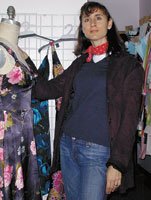Mica's Contemporary Vision
After sales at Mica slumped more than 20 percent in five years, Denny Rabineau decided to take action.
The president and owner of the Los Angeles label, known primarily for its better misses dresses and sportswear with vintage styles and details, decided to take his line up a notch or two.
The veteran apparel maker hired a new design team, got a new showroom and developed a new marketing strategy to slip into the contemporary womenswear category with a more feminine collection. He even changed his business cards, giving them a modern, clean typeface.
“We have to go where we think the action is,” Rabineau explained. “And that meant finding our niche and staying focused on our customer.”
The search for a new niche came after some financial challenges. When annual sales slipped from $10.8 million in 1998 to $8 million in 2003, Rabineau said he knew something had to change at his 15-year-old label.
Last spring, Rabineau hired designer Andrea Polizzi, who revamped the line’s 100-piece collection for Spring/Summer 2004. Polizzi began by adding fine fabrics— such as stretch cotton, silk, stretch jersey, jacquard, tweed and boucleacute;—and new prints to the collection, which still has its share of classic silhouettes and details.
Broadening Mica’s updated misses customer base to include a contemporary customer was a top priority for Polizzi.
“My goal is to make the line au courant and give the customer a reason to rediscover [Mica] and want to buy it again,” she said. “I want to bring in fresh silhouettes and current trends that don’t seem too faddish.”
Polizzi shortened skirt lengths for a flirty, feminine feel and added item-driven separates that can work with other pieces or stand alone. The line also uses embroidery, appliqueacute;s, pleating and other novelty details for a modern, tailored look with all the classic charm of a flea market bargain.
Fall deliveries include jackets and boot-cut pants in tweed and boucleacute; fabrications with retro buttons, dressmaker hooks, eyes and snaps. The line’s silk bias-cut skirts with handkerchief hemlines and printed silk dresses with floral and abstract polka-dot prints are sophisticated and ladylike.
Managing metamorphosis
“Buyers still envision us as a print, rayon and georgette house,” said National Sales Manager Nisa Zap. “We’re still a print-driven company but with a much stronger emphasis on contemporary styles and updated fabrications.”
As part of the shift in business, Mica moved from its California Market Center showroom to a brightly lit loft in The New Mart building in downtown Los Angeles.
Mica’s new focus is growing the line’s specialty store accounts, Rabineau said.
“I like that Mica has updated its style and has behind it all of the knowledge and experience that can create a line of clothes that I want to wear,” said Wendy Freedman, owner of specialty boutique chain Polka Dots & Moonbeams Modern in West Hollywood, Calif., where Mica’s sales doubled last year.
Growing the business
Currently, Mica is on track to reach $10 million in sales this year, said Rabineau, who had been a partner for 10 years at Los Angeles–based childrenswear company Great Escape.
In 1989, Rabineau and his wife, Judy, launched Average Joe Inc., which used leftover material from dresses to make tube tops and elastic hair bands. The company’s clients included Millers Outpost and Paul Harris. Then the two came up with the Mica dress label, and sales began to grow.
The line wholesales from $50 for a skirt to $110 for a dress.
While Mica has found a new future in specialty store business, it continues to push forward with its better department store accounts. Department stores such as Nordstrom’s young contemporary department, TBD, and select Macy’s West, Dillard’s and Bloomingdale’s stores will carry the line for Spring/Summer.
“Mica’s updated collection has evolved into a key items business that’s usually ahead of the trends,” said Dillard’s buyer Pamela Keith.
Local advantage
Mica produces the line through local contractors and must compete with women’s apparel makers that pay lower labor costs through offshore production.
To make sure styles are right, some items are tested at select retail stores.
The line fared well at MAGIC International in Las Vegas and the Fashion Coterie in New York.
“We updated basics that did really well for us,” Rabineau noted. “We realized that we don’t have to be everything to everybody. We just have to be focused, and that focus has to be narrow and deep.”























